We carefully consider a wide range of variables when reviewing student applications.
Please keep in mind that as each application is reviewed, we do so only in the context of the student’s potential eligibility for enrollment at The Bridge School given our classroom openings at the time.
The list of questions below is considered only if the Essential Eligibility Criteria are met.
- Can the Bridge School educational staff appropriately meet the health, safety, and physical care needs of the child throughout the school day?
- Is our classroom environment appropriate to meet the learning needs of this student without significant alteration to our staffing and physical setting?
- Has the student’s family developed a working relationship with their home school district and informed appropriate school district representatives of this application to The Bridge School?
- Does the student demonstrate “readiness” to benefit from classroom-based educational activities such that transition back to the student’s home school district can occur within a reasonable timeframe?
- Is the student adequately positioned for independent seating and access to assistive technologies?
- Is the student’s home school district within reasonable proximity (e.g., commute distance) to Bridge School for effective collaboration and transition support?
- Is funding available to cover the student’s tuition at Bridge School through the child’s home school district or some other funding source?


